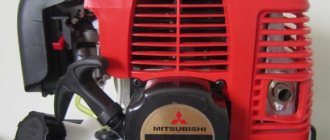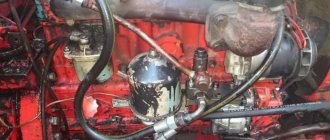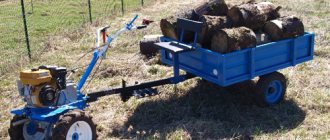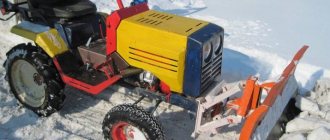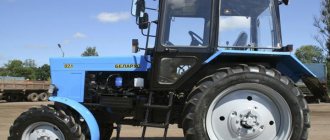MTZ-82 is a universal tractor built on the basis of the MTZ-80 model. It has several modifications, including the MTZ-82.1 with all-wheel drive and a more spacious cabin. There is also an improved version MTZ-82.1 23/12 with larger front wheels and a front beam axle. In addition, the MTZ-80 family is also represented by the 82K version with the ability to work on steep slopes up to 20 degrees.
Another modification - MTZ-82MK - is widely used in housing and communal services. This model is equipped with a less powerful engine and wheels of the same size. The maximum speed of this model is limited to 36 km/h.
How much oil to pour into the engine of the MTZ 82 tractor
First generation from 1974
MTZ-82 is a rear-wheel drive tractor from the Minsk plant, which is an improved version of the rear-wheel drive MTZ-80. It entered production in 1974, and a year later its tracked version, the T-70, appeared. The tractor received a D-240 engine with a volume of 4.75 liters and a power of 80 hp. With. In addition, a 10-horsepower PD-10 starting engine with a longitudinal arrangement is provided. It is coupled with a manual transmission with a single-plate clutch.
In 1985, a hydraulically controlled transmission appeared. The rear axle is equipped with a differential that can be locked by pressing the pedal in the driver's cab. The list of MTZ-82 hydraulic equipment includes a valve-spool hydraulic distributor, a rear hydraulic cylinder, a position/force regulator, a hydraulic cylinder and an NSh-32 gear pump, powered by an engine.
Diesel engines since 1974
4.75 l D 240 (78-81 hp), oil volume - 15 liters, API-CD, SS; SAE 15W-40, 5W-40
Adjusting the locking mechanism of the control levers of the GSV and the distributor.
Check the correct adjustment of the locking mechanism as follows:
a) set the GSV handle to the “pressure release” position, while the distributor handle should automatically move and remain in the “lift” position;
b) set the GSV handle to the “GSV off” position, and the distributor handle to the “floating” position. The GSV handle should not move upward from the “GSV off” position under the action of the plate. If these conditions are not met, adjust the length of the rod that controls the main cylinder spool.
Unoriginal
For the MTZ-82 tractor with the D-240 engine, you can select oil of various viscosities. For example, 5W-30 is suitable for winter use, and for year-round use, you can opt for all-season oil 10W-40, 10W-30 or 5W-40. In addition, you can pay attention to well-known brands with a good reputation (Lukoil, Gazpromneft, Kixx, Shell, Valvoline, Mobil, Castrol, Liqui Moly). Below are suitable motor oils for MTZ-82.
Basic:
- Naftan D3 SAE 10W-40, 15w-40, 20W-50
- Lukoil Avangard SAE 10W-40, 15W-40
Summer:
- M10DM according to GOST 8581-78
Imported analogues:
- Ursa Super TD Texaco
- Teboil Super NPD
- Essolube XD-3+Multigrate
Brands and filling volume
When performing maintenance, you should not be guided by the data in the table of container volumes, because in most cases, the volume of liquid to be filled is less.
Calculation of the volume of lubricating and cooling liquids (cooling fluids) is carried out taking into account the required operating conditions of the units, and the volume of the containers intended for them takes into account heating and thermal expansion during operation, the volume of paths and lines connecting the units and containers, and the method of application of the coolant.
For example, for combined lubrication of engine parts, oil is poured into the engine crankcase. It is supplied under pressure continuously to the rubbing surfaces (crankshaft and camshaft journals, intermediate gear bushings and fuel pump gears), the valve mechanism is lubricated under pulsating pressure, and the remaining parts are lubricated by splashing.
The quantity of refilled materials and their brand must correspond to that specified in the technical manual for the tractor, taking into account the time of year and air temperature.
M-8DM (for operation at temperatures below +5°C) and M-10DM (at temperatures above +5°C) are used as motor oil for diesel engines installed on MTZ tractors.
It is allowed to use oil brands M-10G2K and M-10G2 with similar characteristics. The filling volume into the engine crankcase is 12 liters.
The listed brands of motor oil are also used to lubricate the four-plunger fuel pump and air cleaner. The filling volume for the first is 0.25, for the second - 1.5 liters.
At low temperatures - from -40°C and below - it is allowed to dilute the oil by 15% with diesel fuel to lubricate the fuel pump.
The crankcases of the power transmission mechanisms are fully refilled; for a scheduled replacement, 40 liters of transmission oil of the brands TAp-15V, TSp-10, TSp-15K or TAD-17 are required. The same grades are used for the wheel gear, upper bevel pair, drive support and drive pulley; these mechanisms are also filled in full.
The power transmission also includes a reduction gearbox, made in the same housing with the clutch mechanism. A friction-type dry clutch is installed in a dry compartment of the housing; lubrication in the clutch mechanism is required only for the release bearing; for this purpose, solid oil or LITOL-24 is used. Oil from the reduction gear compartment entering the dry compartment is unacceptable.
The following types of engine oil are used for hydraulic system and power steering components:
Lubrication of bearings of many components - bushings, hinges, hubs, cardan transmission supports and others - is carried out with LITOL-24, grease or LCP-GM grease lubricants. These materials are poured using a special syringe through grease fittings.
Reviews
Dmitry, Minsk. I work in the village on an all-wheel drive version of the MTZ-82. Previously, there was an option with rear-wheel drive, and the difference with it is obvious - both in terms of handling and cross-country ability. The tractor supports a large selection of attachments, which makes it a versatile worker when cultivating the soil in different ways. All-wheel drive helps in muddy ground - for example, after heavy rain. In general, with the MTZ-82, unlike the MTZ-80, I now never get stuck in a deep rut.
Alexander, Tomsk. MTZ-82 is an indispensable thing for a simple rural resident with a large land plot. This device is simple and inexpensive to maintain; I have been using it for three years now. Fully serviceable, does not require frequent replacement of components, although they are of rather low quality. The main thing is with what frequency to work and in what climatic conditions.
Features of using refill containers
It is very important to use the correct type of fuel - this will ensure high-quality and reliable operation of all components and assemblies. It should be selected depending on the temperature regime, remembering that the pour point of the fuel itself should be about 10 degrees lower than the ambient temperature. To fill the tank, you can use the summer version of fuel - for temperatures of 0 degrees or more, winter - for minus 20 and 30 degrees (two varieties) and arctic - for minus 50 degrees Celsius and below. At the same time, the use of other types of fuel with a higher viscosity (diesel oil) or lower (for example, kerosene) is, although possible in extreme cases, but completely undesirable, since this significantly impairs the functioning of both the filter complex in particular and all fuel equipment generally.
Before refueling into the tractor, fuel must sit for at least 48 hours, be as clean as possible and not contain water or any mechanical impurities.
It is recommended to refuel at the end of the working day, making sure that the tanks are not left empty for a long period of time - this can lead to the formation of condensation, which over time turns into corrosion. It is especially worth ensuring that fuel production does not reach the point where the intake tube is exposed, since this will cause airing of the power system, with its subsequent repair (time-consuming and very expensive) - at least 5-20 liters of fuel should remain in the tank.
Activities
Adjusting the axial clearance in the bearings of the secondary shaft 1—glass of the secondary shaft bearing; 2—adjusting shims The degree of tightening of the tapered bearings is checked with a torque wrench with the gears off. Switching gears on and off is done by moving gears on installed shafts using forks.
If the bearings are adjusted correctly, then the turning torque of the secondary shaft and the gears mounted on it, freed from engagement with the mating gears, should be Nm.
Solid oil and lithol are poured through grease fittings. The stand that fixes the position of the control rod is fixed to the floor, which, when the shock absorbers are deformed, can move together with the cabin within a small range relative to the tractor frame.
The axial clearance in the bearings is adjusted by changing the thickness of the package of split gaskets 6 installed between the cup flange and the gearbox wall.
GOST Removing the control mechanism for the MTZ reduction gearbox, MTZ and gear coupling; pressing the clutch shaft 1—technological bolts; 2— clutch shaft; 3— control mechanism Large free play of the reduction gear shift lever indicates wear of the gear clutch groove shift fork.
The tractor must be equipped with external lighting devices: two low-beam white working headlights located symmetrically with respect to the vertical axis of the machine, front lights with white side lights and orange direction indicators, rear lights with red side lights and orange direction indicators , red brake lights, white license plate light. The layout of the main elements remains unchanged. The letter B after the viscosity designation means that the oil was created by improving the properties of a previously produced one and is its modification. checking the oil in axles 001
Adjustment of power (positional) control mechanisms of the tractor.
Adjust the control sector as follows:
a) move the handwheel-limiter 1 (Fig. 4) along the sector slot forward (along the tractor) until it stops at the edge of the slot;
b) check and, if necessary, ensure easy, free movement of control handle 4 along the sector when turning it forward (along the tractor);
c) check and, if necessary, ensure clear return of the regulator control handle from the “lift” position to the “regulator off” position to lock 3. Sticking of the handle in intermediate positions is not allowed, as it can cause excessive heating of the oil in the hydraulic system when operating the tractor;
d) loosen the bolts 5 securing the sector and turn it forward until it stops against the bolt with the edge of the adjustment groove;
e) turn the regulator handle forward until it stops against the handwheel-limiter;
f) turn the handle 4 of the regulator “towards you” along the sector until the internal spring of the regulator begins to compress to select the clearances in the control. Holding the handle in this position, move sector 2 until the handwheel-limiter stops in handle 4 and in this position of the sector, securely fasten it with bolts;
g) ensure clear fixation on the teeth of the sector, as well as the possibility of convenient installation of the handle in the desired position by tensioning the spring of the locking device 6.
On a tractor with a unified cab, adjust the governor control as follows (Fig. 5):
1. Remove the side console cover.
2. Adjust the length of the rod 5 so that when moving handle 1 back (along the tractor) a gap of 18-24 mm is formed between the rubber roller 4 on this handle and the edge of sector 3.
Adjust the position rod as follows:
a) loosen the lock nut on the adjusting coupling 17 of the rod 7 (Fig. 6)
b) set switch 2 to the middle position;
c) lift the attachment to its highest position;
d) move position rod 7 forward (along the tractor) until the longitudinal groove at the end of rod 7 stops with pin 11 on lever 12;
e) change the length of the rod with the adjusting coupling 17 so that the switch 2 with its protrusion fits freely into the groove of the position lever 3, then shorten the rod 7 by 1/2 turn.
c) using an additional lever, create a tensile force of about 400-500 kgf in the direction of arrow “B”, ensuring that the shackle rotates all the way and compresses springs 19. After removing the load from the lever, the shackle should return to its original position, while the sensor stroke, measured according to the movement of power rod 8 must be at least 11 mm;
d) after making sure that the sensor is in good condition, unspread the castle nut 18, tighten it until the sensor springs begin to tighten, then tighten it an additional 1/2–1/3 turn until the slot in the nut coincides with the hole for the cotter pin and tighten it.
Adjust the power traction after adjusting the power sensor:
a) loosen the lock nuts on the adjusting coupling 4 of the rod 8 (Fig. 6);
b) set switch 2 to the middle position;
c) using an additional lever, create a force to ensure that the earring rotates to its extreme position (in the direction of arrow “B”);
d) holding the lever in the depressed position (in the direction of arrow “B”), try to insert the protrusion of switch 2 into the groove of power lever 1. If this fails, change the length of rod 8 with clutch 4 so that switch 2 with its protrusion fits freely into the groove of the power lever 1;
e) shorten the rod by rotating clutch 4 by 1/2 turn;
f) secure the coupling with 4 nuts.
When an agricultural implement is mounted on a tractor, the use of a special additional lever is not required. To adjust the power draft in this case, it is enough to lift the implement above the surface of the platform on which the tractor stands, while the mass of the implement will create the necessary tensile force on the power sensor through the central link. It should be remembered that in this case the central link must be installed on the upper hole of the hitch link. Raise the implement only until it is off the ground.
Lubrication table
** Filling tanks for FDA with planetary helical gearboxes are given in parentheses.
Note: If in winter there is no motor oil of the required grade, it is allowed to use summer grades of oil with the addition of 15% (by weight) of winter grade diesel fuel.
Transmission oil is a lubricant used to lubricate gearboxes, transfer cases, main gears of drive axles, steering mechanisms with gear and chain drives of all types.
The marking is made by combining the first letters T (means transmission). According to GOST 17479.2-85, in the designation of gear oil it is allowed to use the abbreviation TM and numbers that indicate a certain group of oil containing additives and viscosity classes. For example, TS-3-1N means gear oil belonging to the third group and fourth viscosity class.

